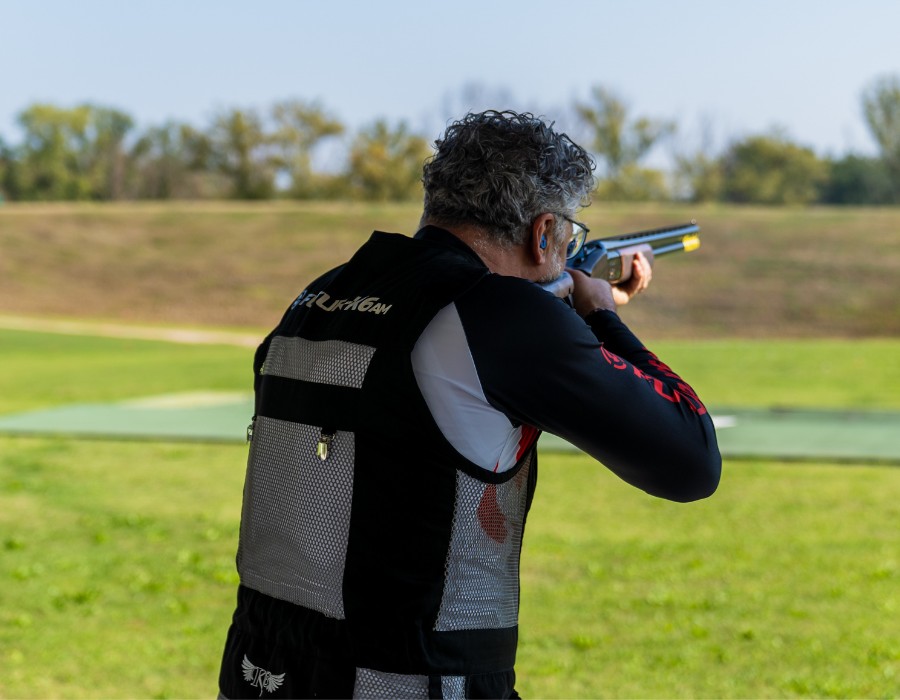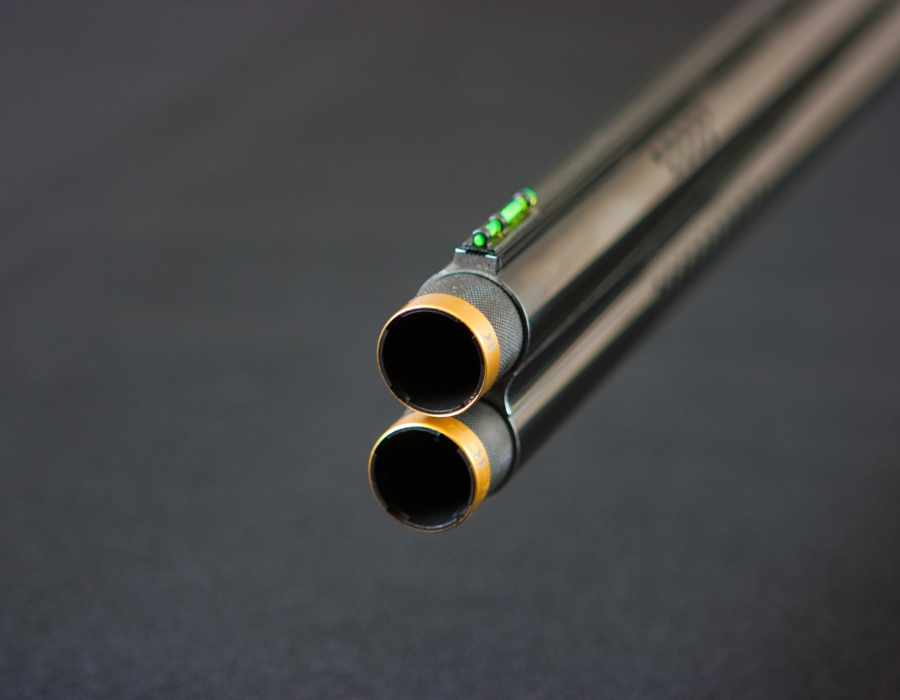The technological development applied in the production of smooth-bore sporting guns has made it possible to have shotguns for clay pigeon shooting that are fully suited to the shooter’s needs.
Everything is designed to make your sports life easier and more stimulating because a shooter who manages to hit several targets is more motivated.
So, modern shotguns present technical features such as the adjustable stock, which allows you to adapt the fold and advances according to the shot required. Subsequently, you can adjust the barrels, which, thanks to the internal chokes, in/out chokes, and the extensions, give you the possibility to adapt the shot pattern, accentuating or decreasing the dispersion based on the target engagement distances and the shooting specialty.
Speaking of adjustable chokes, one cannot fail to mention the Mobil Chokes.
Let’s leave aside for the moment the whole story of the smooth-bore choke, which went through two important steps: the revolution of the Greener harquebuses company in 1873 and the birth of Quick Chokes, forerunners of modern Mobil chokes, around 1980.
For first-time shooters at the shooting field, it is normal to feel displaced and confused when trying to identify the right adjustable shotgun choke.
The choke depends first on the shooter’s shooting method and other factors, such as the type of ammunition used, the target engagement distance, and, as a result, what type of clay pigeon shooting discipline is practiced.
Let’s try to shed some light on this particular technical aspect of clay pigeon shooting.
In particular, in this article we will talk about:
What are adjustable chokes?
What is meant by an adjustable choke? Today many shotguns, including those for clay pigeon shooting, are fitted with barrels with adjustable chokes, that is, predisposed to the use of chokes. That brings us to the famous Mobil Chokes, which allow you to modify the narrowing of the barrel near the muzzle and enable you to pass from the full choke to cylinder, up to skeet, in only a few steps
These barrels are born as almost cylindrical tubes (excluding the narrowing of the combustion chamber, i.e., the so-called drilling) or particular barrels such as the “Tri-bored” or “Back-Bored“, which in the terminal phase, in the internal part, have a thread to which a movable choke is screwed (always internally). In this case, you can choose between the different degrees of narrowing, according to your shooting needs.
The values of the choke and the various types
The chokes of smooth-bore shotguns are measured in tenths, but conventionally, and more practically, they are identified with “stars”: the full choke, that is, the one that in 12 gauge, with the right ammunition, allows us to shoot up to 50 meters, which we identify with *.
A “Full Choke” has a narrowing between 9 and 11 tenths. There are also 12 tenths, and in this case, we will talk about “Extra Full“; for even more extreme shots are the “Ultra Full” with 14/16 tenths of narrowing.
To obtain an extended range without the excesses of shot concentration like the previous ones, a narrowing of between 7 and 8 tenths will be used instead. This choke is identified as “Improved Modified” or **.
The ***, or “Modified”, is a choke that allows you to make excellent shots at medium distances, managing to carry a fair amount of lead even over long distances.
The “Cylinder Modified” or ****, the “Cylinder” or *****, and the “Skeet” choke, which has a negative taper (trumpet), are the most used in short or very close shots.
The right choke for clay pigeon shooting
Apparently, this is a simple and obvious aspect linked to the shooting activity that is practiced.
Specifically, we will take a look at how to choose the right choke in the Olympic pit, clay pigeon shooting, Double Trap, Skeet, and Compak, and finally in Sporting.
The right choke for clay pigeon shooting in the Olympic pit
In the Olympic discipline of clay pigeon shooting, when the target is already engaged at a distance of 25 meters, it seems logical, especially for those who use the aiming style and do not shoot as soon as the target is revealed, use the maximum chokes with ** in the first barrel and * in the second barrel.
As previously described, these chokes compact the swarm, allowing the shot to resist friction with the air better and travel greater distances while maintaining the right speed and dynamic release for breaking the target.
However, depending on the type of bore in the barrels, their length, and the type of ammunition used, you could also opt to use a “Modified” choke in the first barrel, always leaving the full for the second barrel, since the engagement of the target being recovered will be at least around 40 meters.
Furthermore, by using Mobil Chokes, you will have the possibility to use an in/out choke tube. Once mounted inside the choke tube seat, they protrude from the muzzle by 5 or 10 cm, increasing the surface of the tube and allowing the swarm of pellets to travel protected a few more centimeters, delaying the friction with the air and managing to recover a few meters in the usefulness of the shot.
“Ported” chokes can also be inserted. These, always with different degrees of narrowing, have special perforations, or vents, allowing the gases of the blast to disperse quickly at the barrel’s exit, and once their thrust function has finished, thus avoiding affecting the swarm of the shot negatively when it exits from the muzzle.

The right choke for Double Trap
In the Double trap discipline, when the shooter has to hit two targets at the same time, is necessary to have a slightly more generous pattern than the first barrel (therefore a *** star is perhaps more appropriate), then immediately focus on the second target whose recovery will be entrusted to the second barrel which will certainly mount a * choke.
Nevertheless, based on the shooter’s shooting speed, you could also opt for a **, which, avoiding excessive concentrations of the swarm of pellets, could allow you to hit the target even with some peripheral pellets, giving you the point.
The right choke for Skeet and Compak
And for those who want to dedicate themselves to Skeet? Here, the appropriate distinctions must also be made regarding the specialties practiced. Let’s say right out of the gate that Mobil Chokes and all shotguns allow you to change the setting, folds, and range because otherwise, it would be necessary to have a shotgun dedicated to each specialty.
Both in pure Skeet and the hunting course intended as Compak, which take place on the platform, more or less long barrels with slightly wider chokes are tolerated (for example, **** / ** or **** / * **), but also cylinder and skeet, accompanied by less taut folds of the shotgun than in the pit where all shots are upright.
The right choke for Sporting
Sporting, on the other hand, requires short barrels and skeet chokes, a trumpet in the first barrel and a *** or rather **** in the second barrel, because this itinerant activity involves sudden releases. Moreover, the shots are very short and close together, simulating flight or the movement of game, for which it is necessary to have the maximum opening of the pattern within the first 20 meters.
The shooting setting will also be different, and it will be necessary to have a fold of the hunting stock because there will be many lobbed shots and ground shots to hit the “hare” target.
Conclusion
The novice shooter, or those who want to try different disciplines for pleasure or to identify the one that best suits them, will certainly find a valid “ally” in the use of modifiable shotguns, regarding the stock, for the fold and advance, and barrels, as seen above, for the different narrowing possibilities thanks to Mobil Chokes, thus making the choice much easier.


